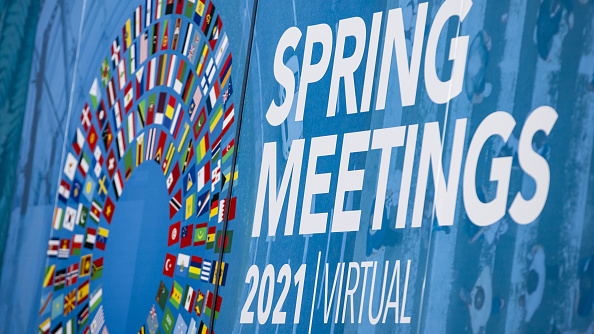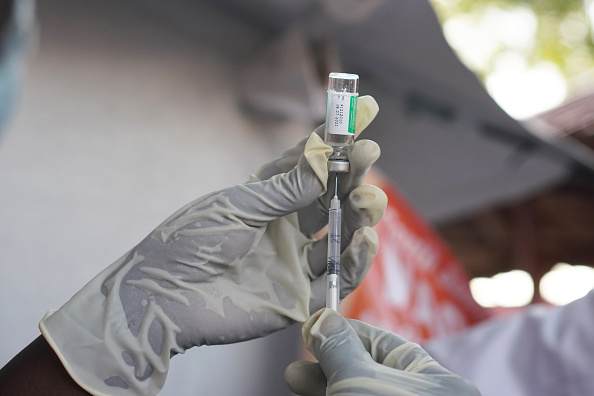
Editor's note: Jeffrey D. Sachs, a professor at Columbia University, is the director of Columbia's Center for Sustainable Development and the president of the UN Sustainable Development Solutions Network. The article reflects the author's opinions and not necessarily the views of CGTN.
This week's spring meetings of the International Monetary Fund and the World Bank offer a historic chance for financial cooperation. The major economies, including the United States, the European Union, China and other G20 countries, have already signaled their support for a new allocation of $650 billion worth of the IMF's reserve asset, special drawing rights (SDRs), to ensure that governments in low-income and middle-income countries have the means to combat the COVID-19 pandemic and start on the path of investment-led recovery. With leadership, boldness and creativity, this global financial cooperation can help to end the pandemic.
Mass immunization is key. Less than a year after SARS-CoV-2, the virus that causes COVID-19, was first identified and sequenced, financial backing by governments – including the U.S., the UK, Germany, Russia, China and India – enabled several companies to roll out safe and effective vaccines. Rich countries that quickly negotiated favorable deals with vaccine makers have received most of the doses so far. But ending the pandemic requires that all countries achieve comprehensive vaccine coverage as soon as possible. In practical terms, the target should be no later than the end of 2022.
Such an unprecedented global undertaking requires strong cooperation, including financial support. Yet the urgency should be clear to all. As long as COVID-19 persists at high rates of transmission anywhere in the world, the pandemic will continue to disrupt global production, trade and travel, and will also give rise to viral mutations that threaten to undermine previously acquired immunity from past infections and vaccinations. Still worse, on the current trajectory, COVID-19 could well become endemic in many regions of the world, imposing high health and economic costs for years to come. As U.S. Treasury Secretary Janet Yellen emphasized this week, all countries, therefore, share a strong interest in ending the pandemic everywhere.
The world's governments established the Access to COVID-19 Tools Accelerator (ACT-A), which includes the COVID-19 Vaccine Global Access (COVAX) facility, the vaccine pillar of ACT-A, to ensure universal control of SARS-CoV-2. But while ACT-A and COVAX have established global plans for vaccines, tests and treatments, the plans need urgently to be strengthened for two closely related reasons.
First, the operational target currently used by COVAX – a minimum of 27 percent of all eligible countries' population immunized by the end of this year – must be raised to vaccination of all adults by the end of 2022. This is necessary to end the pandemic and to reduce the chances of new mutations.

A COVID-19 vaccination campaign at the Military Hospital in Juba, South Sudan, April 6, 2021. /Getty
A COVID-19 vaccination campaign at the Military Hospital in Juba, South Sudan, April 6, 2021. /Getty
Second, planning until the end of 2022 is urgently needed, given the lead times for scaling up the production and supply chains of vaccines and other crucial commodities. Yet ACT-A and COVAX remain underfunded even for 2021: the $11 billion governments have allocated to date leaves a financing gap of $22 billion for this year – a shortfall that has so far delayed necessary planning through the end of 2022. In the meantime, the current vaccine shortfall is leading countries to scramble to jump the queue, including by paying premium prices. This underscores the urgent need to ensure that all countries, including the poorest, can achieve comprehensive vaccine coverage in a fair and timely manner.
The additional sums needed to ensure universal vaccine coverage by the end of 2022, and other COVID-19 supplies, are modest – perhaps $50 billion for ACT-A. That is a negligible amount relative to the enormous global benefits of ending the pandemic and the massive pandemic-related spending by governments of high-income countries around the world. The U.S. government alone has spent roughly $5 trillion in emergency outlays between March 2020 and March 2021.
To do its job, ACT-A (including COVAX) needs front-loaded funding to cover vaccine needs through 2022. Given that scaling up the production of vaccines (and some other commodities) requires a lead time of six to 12 months, the $50 billion should be guaranteed within the coming weeks, so that ACT-A and COVAX can work with manufacturers to ensure the necessary supplies. The IMF's allocation of new SDRs offers a unique – and perhaps the only – opportunity to get this funding in hand.
When the new SDRs are issued, around $20 billion of new reserves will go directly to the poorest countries. In addition, around $100 billion or more that is allocated to rich countries will be recycled to the IMF to be used for long-term, low-interest loans. IMF Managing Director Kristalina Georgieva has been working closely and creatively with G20 governments to design this novel, promising approach. One excellent idea is to use the SDRs to bolster the IMF's Poverty Reduction and Growth Trust (PRGT), the Fund's financing window for poor countries.
There is an important precedent here. In 2015, the IMF created the Catastrophe Containment and Relief Fund to help provide emergency Ebola-control financing to Guinea, Liberia and Sierra Leone. This time, the PRGT financing could be made conditional on its use for ACT-A- and COVAX-related procurements and for other COVID-19 control measures that the borrowing government documents to the IMF (such as reimbursements for COVID-19 vaccines that have been contracted by the member state outside COVAX).
ACT-A is now preparing estimates of the financing that the world's 92 low- and middle-income countries eligible for COVAX support will need for vaccines, testing, therapeutics and other supplies until the end of 2022. Based on the estimated financing needs, an ACT-A financial plan can be established for each country, to be supported by the SDRs and the expanded PRGT funds.
In the next few weeks, a rational plan to finance all countries' COVID-19 balance-of-payments needs until the end of 2022 should emerge. The IMF was created to handle such a balance-of-payments emergency. Access to IMF financing will protect the well-being and macroeconomic stability of individual countries and the world as a whole. We must seize this critical opportunity for the United Nations, the IMF and key governments – including the U.S., China, Russia, the EU, Japan, the UK and others – to cooperate effectively for the sake of humanity.
Copyright: Project Syndicate, 2021.
(If you want to contribute and have specific expertise, please contact us at opinions@cgtn.com.)

